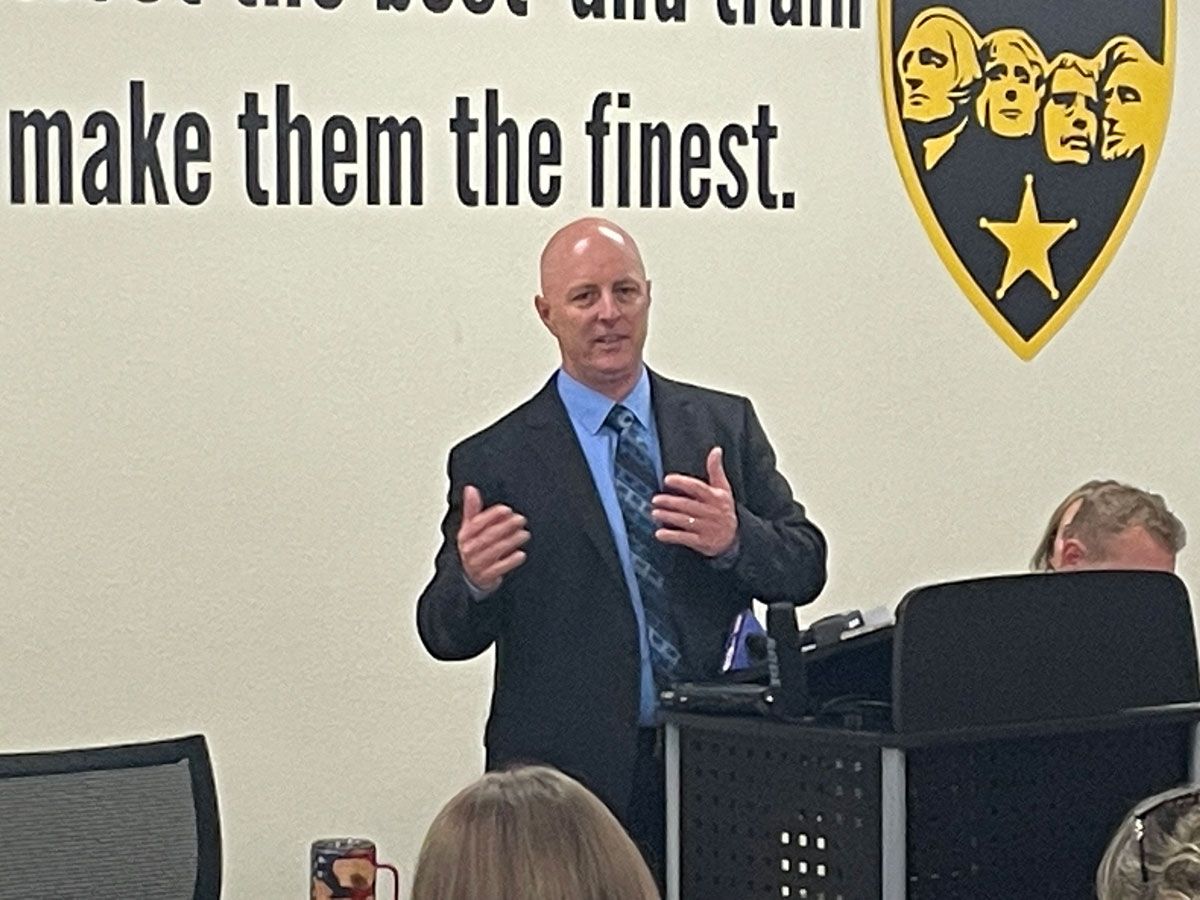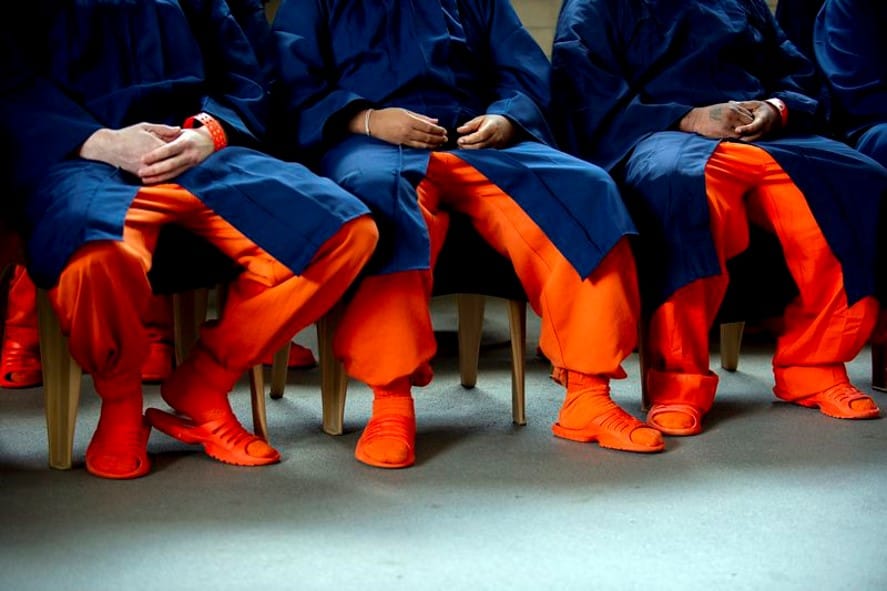RAPID CITY, S.D. – A new education program for jail inmates in Pennington County aims to break the cycle of repeated incarceration among people who are addicted, have mental health challenges or lack the skills to function in society.
Pennington County Sheriff Brian Mueller recently announced the coming launch of the IGNITE program, which will make South Dakota the latest state to implement the effort.
It requires a relatively small public investment and relies largely on strong community support to create education programs to help former inmates gain confidence, learn new skills, get a job, find stability and stay out of jail, he said.
“We’re exploring to see what type of out-of-the-box solutions we can bring to help the people that are in our jails, and the homeless people in our community, change the trajectory of their lives,” Mueller said.
Jail reform: Legislators seek update to South Dakota juvenile justice assessment system
In a nutshell, IGNITE uses motivational techniques to encourage inmates to sign up for education, counseling and job training run by a paid coordinator but provided in person or virtually by educators and experts within the local community.
IGNITE, which stands for Inmate Growth Naturally and Intentionally Through Education, originated in 2020 in Genesee County, Michigan. It allows for flexibility in what training, coursework or skills training are offered to inmates.
The program adds new rehabilitation and reform elements to adult jail populations, which have often fallen behind juvenile jails in regard to educational program funding and options.

‘I was sitting in here hopeless’
In Genesee County, inmates get two hours of educational programming each day. As of August 2022, the program had 15 graduation ceremonies, 2,250 inmate participants and a total of 190,000 teaching hours provided.
At a graduation ceremony in June 2022, former jail inmate Charvel Sims, 56, spoke about how he had been in jail 33 times and in prison five times since 1997.
“Nine months ago, I was sitting in here hopeless,” Sims said. “I had nothing out there to go back to.”
After taking classes in jail in 2021 and 2022, he entered a bricklayer apprenticeship program and landed a job paying $20 an hour plus full union benefits.
“It’s opportunity,” he said. “It’s going to be hard, but don’t give up because there is help out there.”
Never miss a story: Subscribe to receive the latest from News Watch in your inbox
In addition to promoting self-confidence and self-worth in inmates, the training in the trades and other high-demand skills have helped reduce the labor shortage that plagues South Dakota and many other states.
Officials from other states also report that IGNITE reduces violence in jails, raises morale among inmates and officers and has lowered recidivism rates.
Researchers from Harvard University and the University of Michigan are undergoing in-depth analysis and study of IGNITE to further quantify results.

South Dakota is eighth state to have an IGNITE program
Jails in eight states are using the program. Pennington County will be the first to launch IGNITE in South Dakota.
Mueller and sheriff’s office staff members visited jails in North Dakota and Michigan, and Mueller went to Washington to meet with officials who are already using IGNITE.
The visits persuaded Mueller to believe that it had great potential for inmate reform and was worth the effort to implement it in Pennington County. Upon return, Mueller said he discussed the program with numerous stakeholders in the Rapid City area and was met with overwhelming support.
“With each conversation I had, we got new ideas for partnership that can have a positive impact moving forward,” he said.
“This is truly a partnership of our community, to come together and talk to what basic skills we can give to our inmate and homeless population to improve their trajectory in life, and so those of us in public safety can focus on those individuals who aren’t willing to change their behavior and we can hold them more accountable.”

IGNITE will launch in Pennington County as soon as a program coordinator can be hired and community partnerships are firmly in place, said Helene Duhamel, spokeswoman for the sheriff’s office.
The program will likely include drug and alcohol counseling and educational programming through the Rapid City school system and Western Dakota Technical College, Duhamel said.
The anticipated costs, the largest piece being the coordinator’s annual salary of $60,000 to $70,000, will be funded through use of open sheriff’s office positions that are already budgeted as well as some federal opioid funding, Duhamel said.
Possible blueprint for other South Dakota counties
By launching IGNITE first, Pennington County hopes to provide other South Dakota counties with a replicable model and provable results that could benefit communities across the state, Duhamel said.
Minnehaha County Sheriff Mike Milstead said he is aware of the effort in Pennington County and is watching to see what results it might generate, especially since the two county jails are similar in size and population.
Milstead said he appreciates that Mueller is trying to innovate, especially since the necessary public funding level is low and he already has the money in his approved annual budget.
Yet Milstead said he isn’t sure if IGNITE would be a good fit in Minnehaha County now because of the nature of the current jail population and existing pre-trial intervention and assistance programs to aid inmates upon re-entry to society.

Due to recent reforms in managing people facing criminal charges and new efforts to improve sentencing of low-level offenders, most inmates serve a short time behind bars and spend more time being monitored outside the jail, Milstead said.
In an effort to provide low-risk defendants a better chance to maintain stability in their jobs, homes and families, judges have become more willing to provide pre-trial release to low-risk offenders, he said.
Inmates spending less time in jail due to technology and accountability
To further reduce the jail population and costs, Minnehaha County has implemented several high-tech monitoring and testing programs to keep track of pre-trial or low-level offenders without keeping them in jail. Those include ankle monitors and a 24/7 drug and alcohol testing program that requires twice-daily testing in most cases.
“We put in a lot of effort into working with the courts, working with the judges and the judicial system to make sure that the people who are in our jail need to be in our jail,” he said. “Over time, we have transitioned into 24/7 and other out-of-custody programs to keep low-risk offenders out of jail.”
As a result, the jail typically has about 500 inmates, about 80% of whom are on pre-trial status, so only a small portion of the roughly 20,000 people who are booked on criminal charges each year spend any significant time locked up, Milstead said.
Additionally, as more low-level offenders have been removed from lockup, the people who are in jail tend to be charged with more serious crimes and have exhibited more dangerous behaviors, Milstead said.
Violent histories make those inmates unsuitable for work-release programs, in-house or even virtual education or training programs, especially those that might involve a volunteer teacher from the community, which is the norm in some IGNITE training programs.
“As our makeup of inmates has changed, we have more and more people in jail who are dangerous,” Milstead said. “We have a lot of people in jail who are classified as maximum security. And obviously I’m not going to send a teacher in to sit down with them and do bookwork.”

‘Trying to set them up for success instead of failure’
Milstead said he believes Minnehaha County is doing a good job of preparing jail inmates for success upon release.
The sheriff’s office has a voluntary intensive case management program called Alliance in which the jail partners with the county human services department to provide pre-release services to help inmates land on their feet upon release.
The program offers inmates access to a range of existing community services that can provide them with food, clothing, housing, identification documents, transportation, job assistance or post-release case management. Inmates also can be directed to post-release alcohol and drug treatment or mental health services, Milstead said.
“We try to help them find the resources that can help them re-enter society,” he said. “It’s not always an easy step, so we’re trying to set them up for success instead of failure.”
Milstead said that over the past 25 years, he has had close working relationships with every Pennington County sheriff and added that he hopes the IGNITE program can show positive results that could make it replicable in Minnehaha County at some point.

Ohio program reduced staff time and increased safety
Sheriff Chris Hilton of Sandusky County, Ohio, implemented IGNITE earlier this year and said he saw “immediate success.”
Inmates must first take courses in addiction and mental health before venturing to a wide range of IGNITE programming options that include literacy, financial literacy, music education, and training in the ironwork, electrical and carpenter trades that is provided by local union leaders looking for workers.
His program benefited early on from a $90,000 one-time donation made by a local mental health board and uses limited public funds beyond the cost of the program coordinator.

IGNITE has reduced the time correctional officers spend managing inmates and made the jail a safer place for all, Hilton said.
“What do inmates in a jail have the most of? Time,” he said. “They have lots and lots of time. And if that time isn’t used effectively, you’re going to have problems.”
Hilton said IGNITE uses a simple “meritocracy” system to encourage inmate participation: “If you do X, you’ll get Y.” Incentives are as basic as a compliment, a pat on the back or attendance at Friday movie nights.
Providing inmates with education is important because unlike prisons, the overwhelming majority of jail inmates will be released back into their communities.
“They’re going to be your neighbors, they’re going to be living in your community,” Hilton said.
Police chief hopeful the program will help break negative cycles
Rapid City Police Chief Don Hedrick said he supports any reform effort that can help break the “cycles of violence and victimization” that police officers see every day.
New options are needed for people who cannot on their own break the pattern of criminal activity and repeated visits to the county jail, he said.

“We’re out there encountering folks who are continually involved in the system, and we’re not applying enough intervention points to that cycle,” Hedrick said. “Simply allowing someone to serve their time, get out and be right back in the next day means we’re not investing enough into those intervention points.”
Hedrick said he wouldn’t support IGNITE if it felt like “a soft on crime approach” because dangerous people need to be locked up to keep the public safe. But he is encouraged that it gives inmates a new opportunity to find post-release success.
“This is trying to get help to the folks that want it to get out of this cycle,” Hedrick said. “Give them a chance, give them the resources they need to break that cycle and break the revolving door.”
National Sheriff’s Association endorses program
IGNITE has the endorsement of the National Sheriff’s Association, which represents sheriffs across the country and has helped Pennington County and other agencies with implementation.
Jessica Vanderpool, director of grants for the NSA, said the association sees the program as a way to provide new opportunities to prevent jail recidivism that increases jail population and costs.
“Too often our jails fail to provide inmates with the tools necessary to reenter society and avoid future criminal behavior,” Vanderpool said.
“IGNITE does not just educate. IGNITE also identifies the skills these individuals need for potential employers to engage them and most importantly instills the motivation and self worth to better themselves, which in turn makes society better for all of us.”
Prosecutor and educator support IGNITE
Pennington County State’s Attorney Laura Roetzel said her agency supports the program as a potential way to provide new opportunities for inmates that can make the public safer in the long run.
“We can all agree that there were bad choices that led people to be incarcerated in the Pennington County Jail,” Roetzel said. “We don’t know how their lives might have been different if they had been presented with good options. … And this provides incarcerated people with good options that could create a brighter future for not only that individual but for our entire community.”

Roetzel said she will support any program that adds value to the time pre-trial and convicted criminals spend behind bars.
“The jail should be about safety, and it should be about accountability, but it should never be about wasted time,” she said.
Ann Bolman, director of Western Dakota Technical College in Rapid City, said the school is eager to partner with the sheriff’s office to provide job skills training for inmates.
WDT has already seen strong success in a previous “second chance” program that provided training to inmates.
IGNITE could help ease tight county budgets
Hughes County Sheriff Patrick Callahan said he’s intrigued by any effort to engage in adult inmate training.
Adult inmates aren’t provided education or job training in the Hughes County Jail in Pierre, which has 164 beds and houses roughly 125 to 130 inmates a day, according to county records.
“I’d call it innovative and exciting, and we’re monitoring it very closely,” Callahan said. “I could see this developing into something that others can use.”
Callahan said jails in South Dakota operate on very tight budgets. Finding a way to implement a new program with little public funding would be welcomed, especially in less-populated or rural counties that often operate with fewer resources.
Several South Dakota sheriffs told a legislative summer study committee on county funding that inmate populations are high and budgets are tight across the state, he said.
Providing education and support services is slightly easier at the juvenile jail level because there’s more state and federal money available for those programs compared with adult jails, Callahan said.
“Every jail in South Dakota is struggling right now with limited funds,” he said. “And if this is a way we can offer better, more coordinated services with limited financial impact to the counties, I think it’s exciting stuff.”







